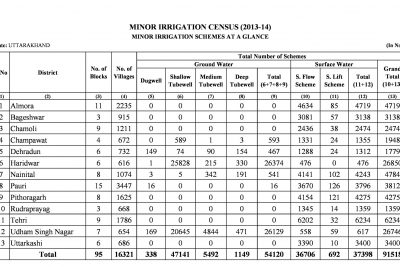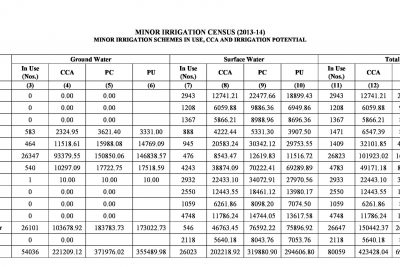Calculation of minor irrigation works
Our country is an agricultural country. About 2/3 of the country’s population lives in rural areas. Agriculture is a major source of employment in rural areas, and most of the population of this region still depends on agriculture for employment. Irrigation facilities play an important role in increasing agricultural productivity. The geographical location of Uttarakhand state is inaccessible, and most of the agricultural area in the mountainous areas is dependent on rain. Almost 100% of the agricultural area irrigated by irrigation facilities in Uttarakhand state is still dependent on minor irrigation facilities for irrigation.
On the basis of irrigation command area, irrigation schemes can be mainly classified into three parts. All those irrigation schemes are called minor irrigation schemes whose agricultural command area (CCA) is less than 2,000 hectares. Schemes with command area of 2000 hectares to 10,000 hectares are called medium irrigation schemes and schemes with command area of more than 1,0000 hectares are called major irrigation schemes.
The specialty of minor irrigation schemes is that they are completed in less time and at less cost, and most of the irrigated area of the state is benefited by minor irrigation schemes. Minor irrigation schemes contribute significantly in increasing agricultural productivity as well as increasing the income of farmers.
Under the Rationalization of Minor Irrigation Statistics (RMIS), the work of calculation of minor irrigation schemes in the country was started. The aim of the scheme was to prepare a strong and reliable data-base of minor irrigation schemes and the benefits received from them in the country, so that the needs of minor irrigation schemes can be known and accordingly planning and policy can be made for minor irrigation schemes in future. The said program is operated by the Minor Irrigation (Statistics) Branch, Ministry of Water Resources, River Development and Ganga Conservation, Government of India. The first minor irrigation census was conducted in the base year 1986-87, after which the second, third, fourth and fifth minor irrigation census have been conducted in different base years namely 1993-94, 2000-01, 2006-07 and 2013-14 respectively. The figures of which have been published by the Government of India. Under the census of minor irrigation works, surface water schemes and ground water schemes are calculated which are used in irrigation works. Under surface water schemes, irrigation means through various means like surface flow schemes and surface lift schemes such as irrigation canal, tank pipeline, reservoir, artesian well, well, shallow, medium and deep tube well, hydro schemes etc. are calculated.
The Minor Irrigation Department is the nodal department designated for conducting the census of minor irrigation works in Uttarakhand. The work of minor irrigation census conducted under the base year 2013-14 has been completed recently by the department. The data of which is available at http://mowr.gov.in/schemes-projects-programmes/schemes/irrigation-census/.
The process related to the calculation of the sixth census of minor irrigation works for the base year 2017-18 has also been started by the Government of India. The specialty of the sixth minor irrigation census is that in addition to groundwater schemes and surface water schemes, the calculation of water bodies available in rural and urban areas is also to be done.




